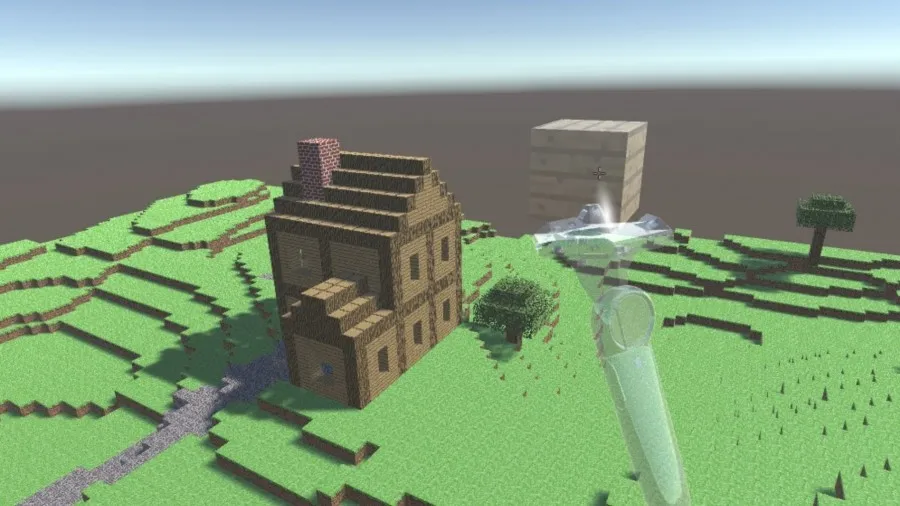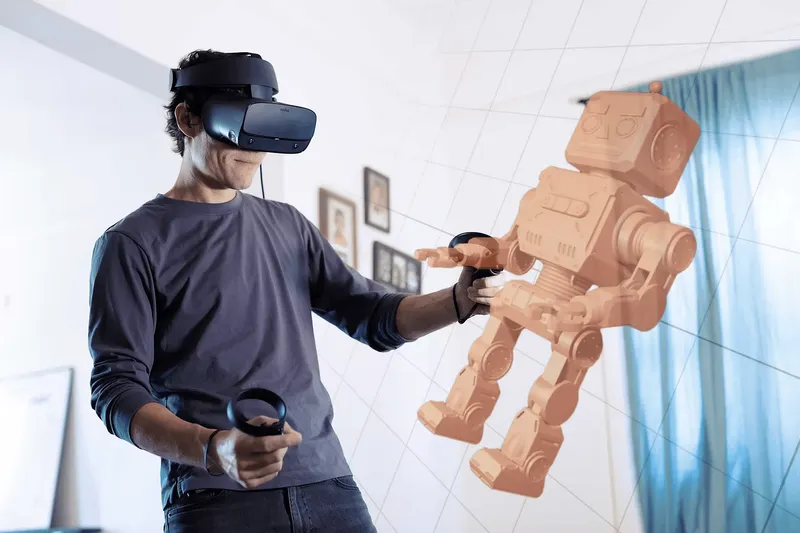A clone of Minecraft that started as an experiment to test out creative gameplay in room-scale VR is now planned as a creation platform that could launch with the consumer availability of the HTC Vive.
James King at Facepunch Studios is the developer behind impressive Minecraft-style videos showing experiments using the SteamVR controllers to create, and destroy, worlds in room-scale VR. The experience turned out to be so “unexpectedly cool” King plans “to ideally release the game in time for when the Vive is available to consumers,” he wrote in an email.
Here is is his latest video showing how to create a roller coaster in the experience:
https://www.youtube.com/watch?v=I0ud4JayYPU
“The pitch is to make it a platform for users to easily create and share their own virtual reality experiences built on top of a voxel engine,” King wrote. “For most that will probably be by building worlds Minecraft style, but you can also create your own plugins for the game with custom art, block types, and even scripted tools and entities. The roller coaster building / riding functionality is an example of this plugin system, built with only the tools that players can use to make their own content.”
How developers use natural human movements to create things in VR is one of the unique qualities of mixed reality that might allow the medium to subsume gamepad-based consoles and keyboard/mouse-based PCs. There’s a reason Microsoft spent $2 billion to buy the company that made Minecraft and Google hired the developers behind VR art creation app Tilt Brush.
Here is our brief Q&A:
How did you get interested in VR?
I think I had an approximately average, somewhat sceptical interest in it until late last year. We were discussing VR in our team chat room and, after I said that I wanted to wait a year or two for the tech to mature before experiencing it, a DK2 landed on my desk.
After trying a few demos that afternoon I couldn’t resist asking if I could take it home for the weekend. A couple of weeks later I had played through Half-Life 2 in VR, which was the best time I’ve had in City 17 yet.
I suppose I wasn’t prepared for how much of a difference there would be compared to conventional monitor displays, which now seem comically primitive when used for 3D graphics. Imagine playing a 3D game with no depth perception! Crazy.
The core aspect of the experience is the feeling that you are inside of a virtual world. The DK2 could give you hints of that, when you were engrossed enough to look past the relatively low pixel density and refresh rate. That was enough to convince me that VR was worth developing for.
What kind of experiences are you interested in playing, and making, in VR?
Honestly, I don’t know what type of experience will be the most enjoyable for me to play in VR. We’ve only just begun to explore what works and what doesn’t, gradually becoming more comfortable with deviating from classes of game that worked well outside of VR. So while I’m not yet sure what kind of experience I would like to play, that lack of knowledge does dictate what kind of experience I would like to make. I want to help myself and others map out potential-game-space by developing tools that let users create and share their own experiences in VR.
Is Minecraft more fun in VR than on a traditional 2D monitor? If so, why do you think that is?
I’ve only briefly tried Minecraft’s Survival mode in VR. From what I remember, the best part was being able to appreciate the huge scale of the landscape around you as you walk around the surface, while caves felt fantastically claustrophobic. That certainly made the experience more fun for me visually, while I can’t remember there being much of a mechanical impact. However, controlling your character’s movement and rotation with a keyboard and mouse feels as awkward as ever in VR, which is something we might not solve for a while in games that expect you to walk long distances. Controllers like the Virtuix Omni might be one way to go, but I suspect we should perhaps focus on games more suited for VR for now.
The project I’ve been working on recently, somewhat jokingly named ViveCraft, was initially a simple clone of Minecraft’s classic Creative mode to see how that would feel in VR. After I got the basics working I couldn’t help but play around with it, and it seemed popular with pretty much everyone that tried it.
Building things in Minecraft is already fun, but made slightly frustrating because you’re doing it indirectly through a keyboard and mouse. With the room scale tracking and motion controls of a Vive you feel exactly like you’re playing with an unlimited set of Lego bricks, albeit bricks you can wave your hand through. Everything feels intuitive, and it’s easy to correct yourself. On top of that you have the visual benefits of virtual reality, the appreciation of scale and feeling of actually being inside of the structure you are building. Because of that, I would say construction games like Minecraft Classic are far more enjoyable in room scale VR.
What did you learn from your ViveCraft work?
So far I’ve learnt a great deal while working on ViveCraft and a couple of other prototypes for VR. Firstly, developing for VR forces you to manage resources well. One of the requirements in producing a feeling of “presence” in a VR game is maintaining a high, consistent frame rate. That’s pretty tough to do in a Minecraft style game, because whenever the world is modified by the player you need to spend some time regenerating the geometry you send to the graphics card. On top of that, you want to spend additional time optimising the geometry you send to make it cheaper to render, for example by merging neighbouring faces and not generating faces that are hidden inside a solid object. Balancing both of those has been challenging but fun, and I’ve learnt many new techniques particularly when using octrees.
I’ve also learnt the importance of giving feedback to players to make interacting with the virtual world feel satisfying. Part of that is visual, like emitting particles from the virtual representation of the controller when the player performs an action. With motion controllers you also have haptic feedback, which is something you can’t afford to ignore. Even vibrating the controller a little when you grab an object or place a block goes a long way in making the player’s interaction with the virtual environment feel bidirectional, it’s enough for your mind to interpret as the virtual object applying an impulse on your hand.
Another thing I’ve learnt through testing is to keep the input scheme as simple as possible. A great benefit of VR with motion controls is the potential for intuitive controls that match how you would perform similar actions in meatspace. However, that can exaggerate a feeling of frustration if your control scheme deviates from intuition. For example, in most cases you will want to avoid making the player press more than one button at a time on a controller, which would otherwise provide far too many combinations of inputs to learn. A better solution is to only require a single button to be pressed at a time, while using controller orientation or gestures to augment input.
I’m also reaching out to other developers working on experiences seeking to harness human creativity in VR. If you’re working on a mixed reality app for creativity let’s get the conversation started by emailing ian@uploadvr.com.




























